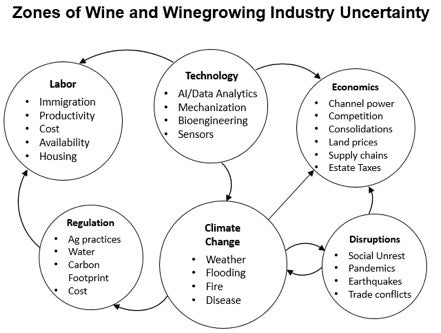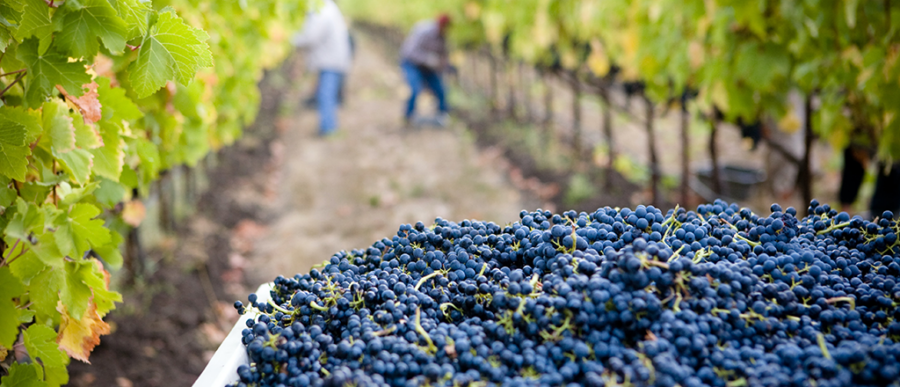For winegrowers, no two seasons are the same. Facing droughts, flooding, wildfires and other unforeseen forces, they have learned to adapt to constant unpredictability. Alongside, winegrowers have been grappling with other sweeping changes, including digital transformation of their markets and rising labor costs – and now, declining tourism due to COVID-19. In this opinion piece, Wharton emeritus marketing professor George S. Day and Karissa Kruse, president of Sonoma County Winegrowers (SCW), explain how winegrowers have benefited from taking the long view, and how organizations like SCW are continuing to prepare for the uncertainty that lies ahead, particularly in relation to climate change.
Most organizations were caught off guard by the ferocity of the Coronavirus pandemic. Some were better prepared to absorb the turbulence and will emerge stronger as the shock waves ebb. These vigilant organizations were better at anticipating what is coming next, while their vulnerable rivals were slower to address the warning signs, and were forced to act defensively.
Vigilant organizations have leadership teams and engaged boards of directors that are committed to being vigilant and make strategic choices that take the long view. They apply a collective capability featuring curiosity, candor, and openness to diverse points-of-view, coupled with a willingness to challenge comfortable assumptions. Their mind-set is, “Just because we’ve always done it this way, doesn’t mean it will keep working in the future.”
Sonoma County Winegrowers (SCW) is an organization that has exercised vigilance and prepared for an uncertain future. It was established by local winegrowing families to nurture and sustain agriculture for future generations. It brings together more than 1,800 wine grape growers and is guided by a mission to preserve and promote this world-class winegrowing region. The organization serves an area with 18 distinct growing regions, planting 66 wine varieties for bottling by 425 local wineries and many wineries outside the Sonoma region.
The way they practice collective vigilance is shaped by the nature of wine — surely one of the most sensitive of all agricultural products to the stresses from climate change — and turbulence in their markets. Growers have had to adapt to hotter summers, warmer winters, droughts, wildfires and flooding that create unpredictability. For grape growers, no two seasons have ever been the same. Over many years they will have been through the full gamut of possible weather patterns and have learned how to adjust. With the greater uncertainty from climate change, this experience matters less. Meanwhile the digital transformation of their markets and distribution channels is rapidly changing how they relate to their consumers.
“Vigilant organizations have leadership teams and engaged boards of directors that are committed to being vigilant and make strategic choices that take the long view.”
By 2010 Sonoma County’s winegrowers were experiencing what Tom Friedman was calling “global weirding.” This launched a period of preparedness, culminating in a commitment in early 2014 to making Sonoma County the first fully sustainable wine region in the world by 2019. This audacious goal was reached in September 2019, with 99% of the vineyards being certified sustainable in the areas of water use, habitat protection, employee safety, employee training and community support. The certification program uses a third party to apply best practices in environmental stewardship.
Climate change and digital advances weren’t the only sources of greater turbulence buffeting the winegrowers: regulation was increasing, labor costs were rising, land prices were escalating, and channel power was shifting downstream to big distributors and retailers. Meanwhile farmland in California was being converted to non-agricultural uses at a loss rate of 200,000 acres each year (1 million acres between 2012-2017 according to the USDA).
To help find innovative solutions to these growing challenges, SCW created in 2017 a forward-looking think tank bringing together a diverse group of thought leaders from outside the usual wine industry settings of consultants, industry publications and familiar interest groups. The Center for Ag Sustainability, as it was named, brought together environmentalists, immigration specialists, economists, small business experts, marketers, wine business leaders and lawyers, while relying on the experience of major winegrowers for regular immersions in the long-run issues. With this cross-fertilization and stimulus, many imaginative solutions have emerged, long-held beliefs have been tested, and early warning signals from other domains were considered for their impact on the wine industry.
Looking Over the Horizon
It is in the nature of uncertainty to defy predictions about the likelihood of events and trends, or their timing and impact. Like all organizations, SCW faces many inter-locking zones of uncertainty. Six zones are shown below, with the arrows between some zones showing interactions that magnify the systemic uncertainty.

Attention may be the scarcest and most valuable resource of a leadership team, and must be allocated carefully to these zones to avoid dilution and distraction. This means deciding which zones have to be watched especially carefully, and then putting action plans in motion. For SCW, the zones of Climate Change, Labor and Economics were the highest priorities, with advances in technology interacting with each zone to generate possible solutions.
The answer to “what’s next?” for SCW is shrouded in doubt while they cope with the abrupt changes in their markets, declining tourism into the region due to COVID-19, and a persistent surplus of grapes. In looking further over the horizon, they agree with the English novelist Margaret Drabble, that, “…when nothing is sure, everything is possible.” They want to keep leading the global conversation on winegrowing stewardship. In early 2020 they invested in a pilot program, in partnership with the California Land Stewardship Institute’s “Climate Adaptation Certification Program.” Twenty vineyards from across Sonoma county were chosen to apply new farming practices to increase carbon sequestration and further reduce green-house gas emissions. This program is further enabled by innovations in computing, sensing and data analytics. SCW is the exclusive participant in this Climate Adaptation Certification Program, which is the first program of its kind available in the world for agriculture. This aim is to test innovative farming practices that will help mitigate the effects of climate change. The pilot offers a customized farm plan that adjusts for variations in soil type, topography, weather patterns, and the growing history of each plot within a vineyard.
“Vigilant leadership teams focus externally and nurture curiosity at all levels and across silos. They are consistently playing a long-game strategy.”
Why Vigilant Organizations Are Better Prepared for Uncertainty
The winegrowers of Sonoma County demonstrate the four features of vigilant organizations described in the book See Sooner: Act Faster: How Vigilant Leaders Thrive in an Era of Digital Turbulence (George S. Day and Paul J. H. Schoemaker, MIT Press: 2019). These distinguishing features have been tested in empirical studies of 118 global organizations, with insights gained from contrasting vigilant firms like Mastercard, Adobe Inc., and Intuit with firms that were blind-sided (such as Volkswagen, Wells Fargo, Danske Bank or Boeing), and augmented by theoretical insights from organizational and strategy research:
1. Leadership commitment to vigilance is demonstrated by an openness to weak signals from diverse sources, by encouraging others in the organization to explore issues beyond their immediate domain and thinking creatively about strategic moves. Vigilant leadership teams focus externally and nurture curiosity at all levels and across silos. They are consistently playing a long-game strategy.
SCW leadership has earned credibility and visibility in industry circles, so they are included early in global wine conversations, wine think tanks such as “Fine Minds 4 Fine Wines,” global trade associations and Vin Expo conference. By participating in these global wine conversations, they get the early signs of emerging trends and impending regulation sooner than most regions. They also encourage the engagement with global networks such as the German Marshall Fund where the organization president is a Marshall Memorial Fellow, and is privy to wide-ranging global conversations about trade, agriculture and economic trends.
As part of their commitment to vigilance, the leadership relaunched the Sonoma County Grape Growers Foundation with a mission to support local farmworkers and their families. Having this organization already in place was fortuitous when Sonoma County experienced the wildfires in 2017, 2019, 2020 and now the COVID-19 pandemic, since there was an infrastructure in place to raise money and support housing needs and the financial stability of farmworkers and their families, ensuring their livelihood and ability to remain in the county and in agriculture.
It is often noted that there are no sacred cows in SCW. Leadership acts to stop programs that are no longer working or don’t deliver a return on grower investment, and the board is extremely supportive of the president trying new things, piloting, and taking thoughtful risks. Among the guiding principles they have embraced and put into practice are: Be bold when it makes strategic sense; leverage joint resources whenever possible; pilot test opportunities that can be scaled and replicated; be flexible; be knowledgeable.
2. Investments in foresight activities are made in systematic ways, for scanning and by using strategic dashboards to monitor relevant future scenarios. Leaders insist on a disciplined search for investment opportunities while building a flexible, real options portfolio to help the organization navigate uncertainty.
A culture of thoughtful risk-taking and scanning for opportunities by SCW led to the development of the sustainability label for wine bottles (now on 1.3 million cases of wine) while using Augmented Reality to tell the sustainability story directly and creatively to wine lovers. They saw very early that sustainability (and where your food is sourced) was gaining traction in other industries and that the wine industry should be ready. This has helped Sonoma County be positioned as the most sustainable wine region in the world.
3. Strategy making processes that are flexible and adaptive by adopting ‘outside-in’ and ‘future-back’ approaches. Outside-in approaches start with how the outside world is changing and not with the current strategy or resources. Future-back thinking asks what it takes to win longer term and how to plant the seeds now.
SCW uses their Center for AG Sustainability to bring outside-in thinking to their long-run strategy issues. The members of the think tank are able to stand back and look at the industry and the challenges facing SCW with fresh eyes and the objectivity that comes from starting with the perspective of stakeholders, including consumers, workers, regulators and the wider community.
SCW was first to write a 100-year blueprint for local agriculture and wine grape growing. The notion is that the period of 100-years represents three generations (grandparents to grandkids), which is how most family farmers think about their business. The process included a review of those factors that has kept grape growing an integral part of Sonoma County since 1812 and what will be needed to remain successful for next 100 years. This very long-term plan is reviewed and updated every 3-5 years.
4. Coordination and accountability for receiving and interpreting weak signals, supported by an organizational norm of sharing information readily. This last driver enables the other three drivers to flourish. By refocusing haphazard initiatives, leaders create the organizational conditions necessary for continued vigilance.
The SCW Board members have committed to work together for the collective benefit of the region. By the nature of their work, they have to respond to seasonal volatility and pivot quickly. They support this skill and flexibility by hiring people who share their values and work ethic.
Within vigilant organizations, these four drivers work together as a system of connected and reinforcing elements, with the leadership team playing a steering role in starting, redirecting and prioritizing vigilance initiatives throughout the organization. Within vulnerable organizations, by contrast, these drivers are uncoordinated and poorly executed, with leadership commitment episodic at best. The limited attention resources of the leadership teams within vulnerable organizations are mostly absorbed by short-run defensive responses to unwelcome surprises. During periods of heightened uncertainty, the performance gap between vigilant and vulnerable organizations will surely widen.



